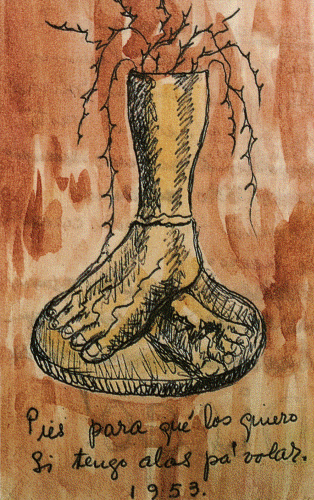DON'T CRY.
Don't cry and wake the
dead,
Lest they turn to a ghost
And fright our little
dreams
Back to the land of
silence.
Don't cry and wake the
gods,
Lest they ask us questions
Of how and why,
Remember our response was
stolen.
Don't put a leave between
your lip,
Lest the deaf turn
mad,
Remember we lost our legs
To the war we fought.
Don't cry you little
child,
Lest your mother asks you
why,
Remember we have no
child,
We have husbands not
fathers.
Don't cry you little
land,
The giants have tread you
to torn,
The rain will soon come,
Then you will have a
say.
Don't cry,
Don't sigh,
Don't die
Don't dry.

Pies para que los quiero, si tengo alas pa' volar (Feet, why do I want them if I have wings to fly?) -- Frida Kahlo
A month before doctors amputated her right leg at the knee, in her diary Frida Kahlo drew a picture of her severed feet on a pedestal. Instead of healthy veins protruding from the amputated feet, dead, thorny vines snaked out, the flesh was yellow, anemic, and the page was stained with her blood. Her real leg was infected with gangrene, shriveled and lame, hanging from her body as though broken. Two toes were missing. In public whe pretended nonchalance, telling her friends, "Did you know they are going to cut off my paw?" At six. she had been stricken with polio in her right leg. She spent nine months in bed. Afterwards she played soccer, boxed, wrestled, and became a champion swimmer, but her leg remined emaciated. Decreased circulatio nled to lifelong problems and pain, which she managed with copious amounts of brandy and pills. Over her lifetime, she would endure over 30 surgeries, multiple hospitalizations, and months of bedrest. Frida managed the constant pain with copious amounts of brandy and pills. Growing up, she wore three or four socks and shoes with an elevated right heel; as an adult she sported elaborate, floor-length skirts. When she was 18, a bus she was riding was rammed by a streetcar, and she was pierced through, "the way a sword pierces a bull,” through the left hip and exiting from her genitals; the collison tore off all her clothing and tore open a packet of powdered gold that overed her bleeding body. Her spinal column was broken in three places in the lumbar region, her pelvis in three places, along with her collarbone and two ribs; her left shoulder was dislocated; her right leg had 11 fractures, and her right foot was dislocated and crushed. Her left shoulder was out of joint, her pelvis broken in three places. The steel handrail produced a deep abdominal wound, entering through the left hip and exiting through the genitals. She convalesced for two years but would never fully recover. Her mother took her a small lap easel, and Frida had a mirror hung in the canopy of her bed, and she began to paint herself. Later, she remarked, “I have suffered two serious accidents in my life, one in which a streetcar ran over me….The other accident is Diego.” Rivera was a couple decades older and living with his common-law wife and their two children. Her father disapproved of his Communism and reputation and complained that it woud be "like an elephant marrying a dove." No one attended their wedding except her father, who told Rivera, "My daughter is a sick person and all her life she’s going to be sick. She’s intelligent but not pretty. Think it over awhile if you like, and if you still wish to marry her ... I give you my permission." Rivera claimed that he was also told she was "un demonio." Rivera's muralist friend Roberto Montenegro Nervo gave them a lavish reception at his house, got into a drunken brawl and broke a man's little finger; the Riveras quarrelled and Frida returned to her parents' home in tears. A ew days later Digo retrieved her and took her to his own house. The pair fought, separated, engaged in many affairs (one pf Rivera's was with Frida's sister, one of Frida's was with her house guest Leon Trotsky), divorced, remarried. A year after her amputation she died from a self-administered morphine overdose, probably a suicide.
ReplyDelete